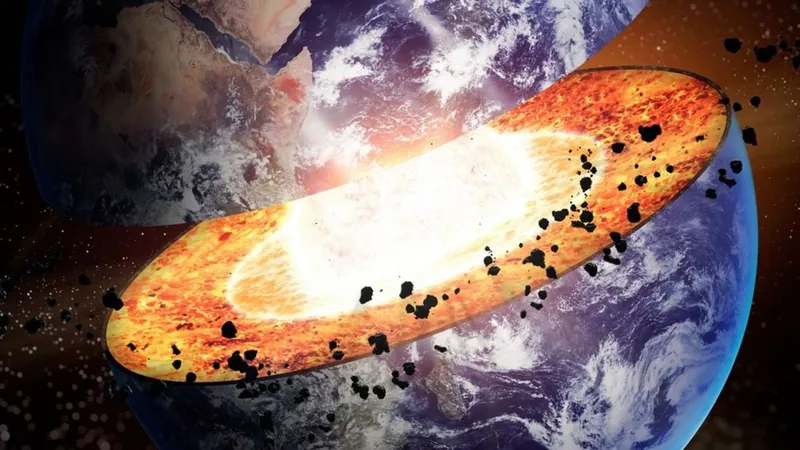
Unbelievable Discovery: Scientists Unearth 'Sunken Worlds' Hidden Deep Within Earth's Mantle!
2025-01-14
Author: Kai
Introduction
Recent research has unveiled astonishing evidence of what some scientists are dubbing as "sunken worlds," potential remnants of Earth's ancient crust lying deep within our planet's mantle. This groundbreaking discovery has emerged through advanced seismic imaging techniques, leaving researchers both excited and perplexed.
Seismic Imaging Techniques
For years, scientists have utilized seismographs to create a detailed picture of Earth's interior by analyzing how seismic waves from earthquakes bounce back after penetrating our planet's layers. This method has proven invaluable in identifying subducted slabs—sections of the Earth's crust that have been dragged into the mantle at tectonic plate boundaries. Notable findings include a recently reported section of ocean floor that has plummeted into the mantle beneath Easter Island, revealing the dynamic nature of our planet's geology.
Recent Study Findings
A study published on November 4, 2024, in the journal *Scientific Reports* has taken this research a step further. Utilizing a novel seismographic imaging technique, scientists have detected numerous enigmatic blobs scattered throughout Earth's mantle. However, the peculiar location of some of these blobs has raised eyebrows; unlike typical subducted slabs found near tectonic convergence zones, these new anomalies appear in regions devoid of any discernable tectonic activity, such as beneath the western Pacific Ocean. This unexpected occurrence has left scientists scratching their heads, pondering the origins of these mysterious formations.
Expert Insights
Thomas Schouten, a doctoral candidate at ETH Zurich, stated, "That's our dilemma. With the new high-resolution model, we can see such anomalies everywhere in the Earth's mantle. But we don't know exactly what they are." It's a statement that underscores the significance of this discovery while also highlighting the gaps in our current understanding of Earth's geological processes.
Theories on Blob Identity
Scientists are exploring several theories regarding the identity of these newly mapped blobs. One possibility is that they represent remnants of crust-like material that dates back to the Earth's formation approximately 4 billion years ago. Alternatively, they might be composed of other dense materials that have accumulated in the mantle over millions of years. Yet, these remain speculative notions, as the true nature of these blobs is still shrouded in mystery.
Innovative Methodology
In a breakthrough approach, researchers employed a technique known as full-waveform inversion. This method integrates seismic data into a single, coherent image, resembling advancements seen in medical imaging technology. Andreas Fichtner, a seismologist from ETH Zurich and co-author of the study, emphasized the significance of this innovation by comparing it to a doctor discovering an unexpected artery during a routine examination, further illuminating the revolutionary nature of these findings.
Need for Further Research
Despite initial evidence suggesting these blobs could be similar to previously identified subducted slabs—since seismic waves travel through them at comparable speeds—more rigorous research is necessary to determine their true composition. Schouten elaborated on this point, stating, "We have to calculate the different material parameters that could generate the observed speeds of the different wave types."
Conclusion
As more research unfolds, the scientific community is left in awe of these "sunken worlds." The implications of such findings could transform our understanding of Earth's history, geodynamics, and the processes that shape our planet's surface. Stay tuned for more updates as this story develops!




 Brasil (PT)
Brasil (PT)
 Canada (EN)
Canada (EN)
 Chile (ES)
Chile (ES)
 Česko (CS)
Česko (CS)
 대한민국 (KO)
대한민국 (KO)
 España (ES)
España (ES)
 France (FR)
France (FR)
 Hong Kong (EN)
Hong Kong (EN)
 Italia (IT)
Italia (IT)
 日本 (JA)
日本 (JA)
 Magyarország (HU)
Magyarország (HU)
 Norge (NO)
Norge (NO)
 Polska (PL)
Polska (PL)
 Schweiz (DE)
Schweiz (DE)
 Singapore (EN)
Singapore (EN)
 Sverige (SV)
Sverige (SV)
 Suomi (FI)
Suomi (FI)
 Türkiye (TR)
Türkiye (TR)
 الإمارات العربية المتحدة (AR)
الإمارات العربية المتحدة (AR)